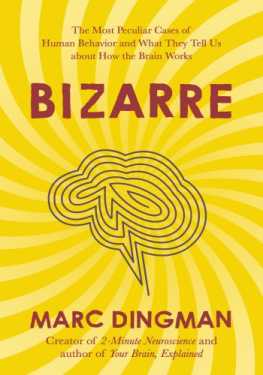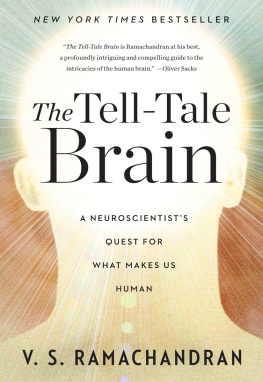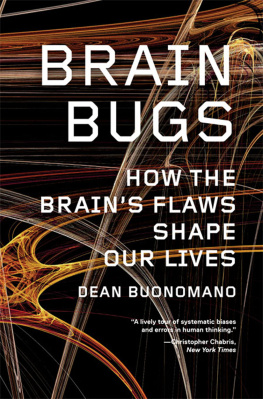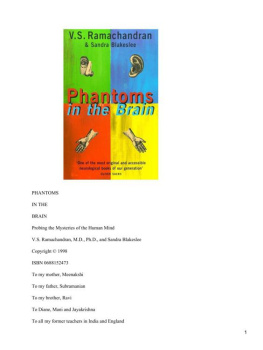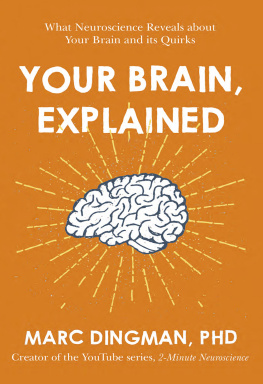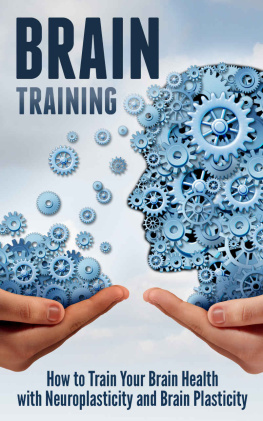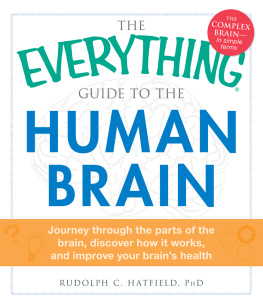Praise for
BIZARRE
Bizarre is a collection of stories of how the brain can create zombies, cult members, extra limbs, instant musicians, and overnight accents, to name a few of the mind-scratching cases. After reading this book, you will walk away with a greater appreciation for this bizarre organ. If you are a fan of Oliver Sacks books, youre certain to be a fan of Dingmans Bizarre.
Allison M. Wilck, PhD, Researcher and Assistant Professor of Psychology, Eastern Mennonite University
Through case studies of both exceptional people as well as those with disorders, Bizarre takes us on a fascinating journey in which we learn more about what is going on in our skull.
William J. Ray, PhD, Emeritus Professor of Psychology, The Pennsylvania State University, author, Introduction to Psychological Science, Research Methods for Psychological Science , and Abnormal Psychology
A unique combination of storytelling and scientific explanation that appeals to the brain novice, the trained neuroscientist, and everyone in between. Dingman explores some of the most fascinating and mysterious expressions of human behavior in a style that is case study, dramatic novel, and introductory textbook all rolled into one.
Alison Kreisler, PhD, Neuroscience Instructor, California State University, San Marcos
Dingman brings the history of neuroscience back to life and weaves in contemporary ideas seamlessly. Readers will come along for the ride of a really interesting read and accidentally learn some neuroscience along the way.
Erin Kirschmann, PhD, Associate Professor of Psychology & Counseling, Immaculata University
Bizarre is one of those rare reads that presents true neuroscientific information in a genuinely accessible manner. Dingmans entertaining writing style crossed with his depth of knowledge on the subject is sure to make this book a valuable asset to both the novice and the practiced scientist alike.
Kate Anderson, PhD, Associate Professor of Psychology, Presbyterian College
BIZARRE THE MOST PECULIAR CASES OF
HUMAN BEHAVIOR AND WHAT
THEY TELL US ABOUT HOW THE
BRAIN WORKS Marc Dingman, PhD
For Michelle.
Without your love and support,
I truly dont know where I would be.
CONTENTS
A t about 11:40 a.m. on a hot, cloudless August day, 25-year-old Charles Whitman took the elevator to the top floor of the Main Building at the University of Texas (UT) at Austin. It was 1966, and at that time the Main Building, known simply as the Tower to students and locals, was the second tallest building in Austinrising 307 feet into the Texas sky from the center of the UT campus.
Whitman was an Eagle Scout, ex-Marine, and a UT studenta six-foot-tall, muscular, blond-haired man who was generally well liked. He used his university ID to get past a security guard, who let him wheel an army-style footlocker on a dolly into the tower. Unbeknownst to the guard, the footlocker contained an arsenal of weapons.
Whitman reached the 27th floor, then took three steep half-flights of stairs up to the observation deck, which wraps around the 28th floor of the tower. When he got to the reception area of the observation deck, he was greeted by the receptionist, 51-year-old Edna Townsley. He immediately attacked her, fatally injuring her with a blow to the back of the headprobably delivered with the butt of his rifle. Minutes later, a group of visitors arrived to take in the views of the city available from the tower. Whitman fired at them with a sawed-off shotgun, killing two and critically injuring two others.
Charles Whitman as he appeared in the 1963 edition of the University of Texas student yearbook.
Then Whitman stepped out onto the observation deck, opened the footlocker, and spread his arsenal out on the floor. He had a collection of pistols and rifles and about 700 rounds of ammunition. Whitman selected a rifle that was designed for long-range accuracy. At 11:48 a.m., he began shooting at people walking on the UT campus hundreds of feet below.
His first shot ripped through the stomach of a pregnant woman, Claire Wilson, immediately killing her unborn son. As Claire fell to the ground, her boyfriend rushed to her to see what was wrong; he was shot in the back and died instantly. Whitmans next three victims were a physics professor, a Peace Corps trainee, and an undergraduate student.
That was all in the first 10 minutes of Whitmans terroristic onslaught. He continued his random attacks on the passersby below for over an hour and a half before police stormed the tower and shot him dead. When it was over, Whitman had killed 14 people (including Claire Wilsons unborn child) and injured more than 30 others. Another student, whose kidney had been severely damaged from one of Whitmans rounds, died in 2001; his death was ruled a homicide.
Of course, the first question on everyones mind after such a tragedy is: Why? What would lead an architectural engineering student who many considered a nice guy to commit this heinous crime?
When police began investigating, more horrific details came to light. Whitman had also used a large hunting knife to kill his mother and his wife in the early morning hours on the day of the shooting.
While searching Whitmans home, police found a note Whitman had typed on a typewriter the night before the attack. In it, Whitman seemed to be trying to make sense of his homicidal urges. He wrote:
I dont really understand myself these days. I am supposed to be an average reasonable and intelligent young man. However, lately (I cant recall when it started) I have been a victim of many unusual and irrational thoughts. These thoughts constantly recur, and it requires a tremendous mental effort to concentrate on useful and progressive tasks After my death I wish that an autopsy would be performed on me to see if there is any visible physical disorder. I have had some tremendous headaches in the past and have consumed two large bottles of Excedrin in the past three months.
Whitmans wish for an autopsy was granted the day after his death. Although Whitmans case was already an intriguing one for sociologists and criminologists, the autopsy caused Whitman to be thrust to the forefront of debates on the brain and behavior. For, when doctors examined Whitmans brain, they found a large tumor impacting a structure called the amygdala , which plays an important role in emotional regulation. (Well talk more about the amygdala in the chapters to come.)
This discovery prompted some to attribute Whitmans homicidal behavior to the presence of the brain tumor. Indeed, it seems plausible that Whitmans tumor could have influenced his amygdala in such a way as to cause unexpected personality changes, potentially leading to his vile actions.
Others, however, are not so quick to blame Whitmans tumor for his crimes. Despite the accounts of Whitman being likable, he had a temper that sometimes frightened his wife, and he admitted to physically attacking her on two occasions. At the time of the shooting, he was also dangerously abusing amphetamine. It wasnt uncommon for him to stay awake for days taking large doses of the drug, behavior that increases the likelihood of violent outburstsand can even cause someone to lose touch with reality.
Regardless, Whitmans case is interesting from a neuroscientific perspective because neuroscientists know we cannot rule out the possibility that his killing spree was attributable to effects caused by his brain tumor. In fact, there are countless other cases throughout history where tumors, strokes, brain damage, and the like led to changes in personality that made the individual barely recognizable to those around them.
Probably the most famous of these is the case of Phineas Gage, a railroad foreman who in 1848 accidentally caused a small explosion that propelled a 3-foot-7-inch, 13-pound metal rod toward his head. The rod was tapered at one end, and it entered Gages face below his left cheekbone, traveled through his skull, carved a hole in his brain, and exited from the top of his cranium with great force, landing some 75 feet away. Amazingly, Gage survived the accident andafter a period of several weeks where his prognosis was grimeventually recovered almost all of his physical abilities except for sight in his left eye.
Next page
